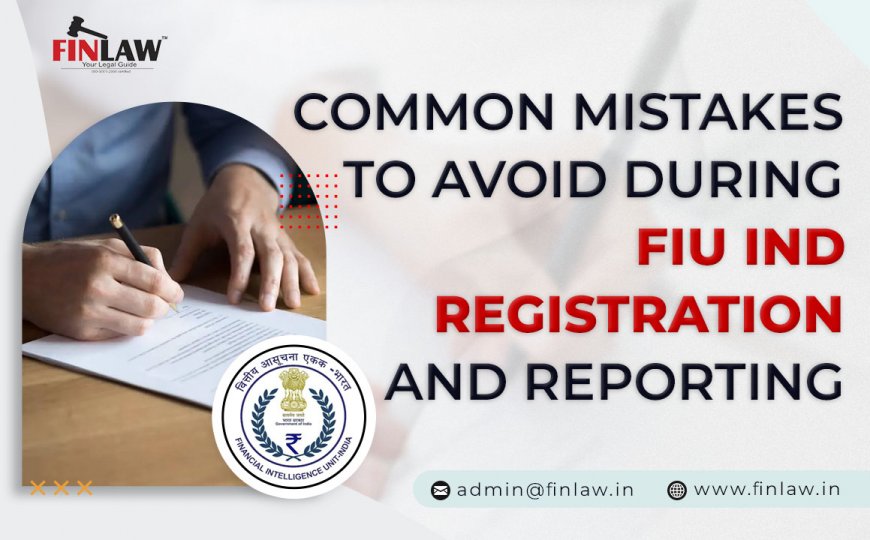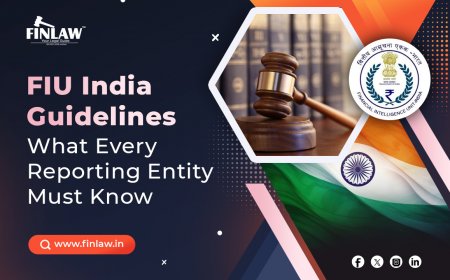Common Mistakes to Avoid During FIU IND Registration and Reporting
Avoid common FIU IND registration & reporting mistakes. Guide for FINnet/FINGate compliance, CTR/STR deadlines, RVU validation & record retention.

Introduction
FIU IND Registration and FIU IND Reporting are not just procedural formalities — they are ongoing compliance obligations under India’s anti-money laundering (AML) and countering financing of terrorism (CFT) framework. Errors in registration or periodic reporting of Cash Transaction Reports (CTR), Suspicious Transaction Reports (STR), and other mandatory filings can lead to regulatory penalties, audit findings, and reputational damage.
In this guide, we break down the most common mistakes reporting entities make, explain their consequences, and provide practical solutions to ensure smooth compliance with FIU-IND requirements.
Understanding FIU IND Registration and Reporting
The Financial Intelligence Unit – India (FIU-IND) is the central agency that collects, analyses, and disseminates information related to suspicious and large-value transactions.
All reporting entities (REs) under the Prevention of Money Laundering Act (PMLA) — such as banks, NBFCs, intermediaries, and virtual asset service providers — must register with FIU-IND through the official FINnet Gateway (FINGate 2.0). This registration process includes:
-
Entity registration: Categorizing your organisation correctly.
-
Principal Officer registration: Designating and registering the individual responsible for reporting.
-
Reporting obligations: Filing CTRs, STRs, CBWTRs, and other mandated reports on time.
Common Mistakes and How to Avoid Them
1. Selecting the Wrong Reporting Entity Category
The mistake: Choosing an incorrect category during FIU IND Registration, leading to misapplied reporting requirements.
Solution: Refer to the FIU classification list in the FINnet/FINGate user guide. Consult legal/compliance advisors if unsure about your classification.
2. Delayed or Missing Principal Officer Registration
The mistake: Not registering the Principal Officer promptly or failing to update FIU-IND when personnel changes occur.
Solution: Make Principal Officer registration a priority. Notify FIU-IND immediately of any changes using the prescribed format.
3. Missing STR Deadlines
The mistake: Delaying STR submission beyond the seven working days allowed after forming suspicion.
Solution: Establish a 24–72 hour internal escalation process for suspected transactions and file STRs well within the 7-day window.
4. Missing CTR / CBWTR Deadlines
The mistake: Incorrect aggregation of transactions or late filing of CTRs, which must be submitted by the 15th of the following month.
Solution: Automate transaction aggregation and set internal cut-offs at least five days before the deadline.
5. Upload Errors Due to Validation Failures
The mistake: XML or CSV reports failing FIU-IND’s schema validation checks, leading to rejection.
Solution: Use the FIU Report Validation Utility (RVU) before every upload. Maintain validation logs for audit purposes.
6. Weak KYC Documentation for STRs
The mistake: Submitting STRs without robust KYC and transaction evidence.
Solution: Maintain a “STR pack” — KYC snapshots, transaction history, internal investigation notes, and evidence attachments.
7. Poor Record Retention Practices
The mistake: Inability to produce transaction or KYC records during audits.
Solution: Retain transaction and KYC records for at least five years as per PMLA requirements. Use encrypted, indexed storage.
8. Outdated SOPs and Compliance Policies
The mistake: Not updating internal policies after FIU-IND updates formats or reporting requirements.
Solution: Maintain a compliance-change log and conduct quarterly reviews of SOPs and staff training.
9. Overreliance on Manual Processes
The mistake: Manual data compilation leads to delays and human errors.
Solution: Automate reporting workflows where possible, keeping manual intervention for substantive review.
10. Poor Inter-Regulatory Coordination
The mistake: Overlapping requirements from FIU-IND, RBI, SEBI, IFSCA, or VARA leading to inconsistent reporting.
Solution: Centralise regulator communications and maintain a single compliance calendar.
STR Narrative Template
When filing an STR, clarity and accuracy are critical. Here’s a template you can adapt:
-
Subject: Customer name / identifier
-
Accounts Involved: Account numbers / product types
-
Transaction Summary: Dates, amounts, channels
-
Red Flags Observed: Structuring, high-risk jurisdictions, inconsistent source of funds
-
KYC Status: Documents on file, anomalies noted
-
Internal Findings: Steps taken, customer responses
-
Reason for Suspicion: Clear and concise explanation
-
Attachments: KYC snapshots, transaction history, communications
Example Case Study
A mid-sized NBFC detected daily cash deposits of ₹48,000 across multiple branches by a single customer. While each transaction was below ₹50,000, the aggregated total exceeded reporting thresholds and indicated possible structuring. The compliance team filed an STR within five days, attaching supporting documents and a clear narrative, avoiding rejection and regulatory issues.
Technical and Operational Recommendations
-
Data Integration: Link core banking/ledger data with KYC systems.
-
Validation Pipeline: Incorporate FIU XSD schema checks into CI/CD processes.
-
Workflow Automation: Use ticketing systems with SLA monitoring for reporting deadlines.
-
Secure Archiving: Encrypt and index all retained records for easy retrieval.
-
Staff Training: Conduct AML/CFT training for all relevant teams quarterly.
Key Compliance KPIs
-
STR filing time (target: <7 days)
-
CTR success rate (target: 100% by 15th)
-
Validation error rate (target: <1%)
-
Record retrieval test success rate
-
Training completion rate
FIU IND Reporting Checklist
-
Register entity on FINnet/FINGate with correct category
-
Appoint and register Principal Officer
-
Aggregate transactions for CTR/CBWTR
-
File STRs within 7 working days of suspicion
-
Validate files using RVU before upload
-
Retain records for at least 5 years
-
Update SOPs after regulatory changes
Frequently Asked Questions
Q. Where can I complete FIU IND Registration?
On the official FINnet Gateway (FINGate 2.0) portal.
Q. What is the STR filing timeline?
Within 7 working days of forming suspicion.
Q. What is the CTR deadline?
By the 15th day of the month following the transaction month.
Q. How long must records be retained?
Minimum of five years as per PMLA.
Conclusion
FIU IND Registration is the first step in meeting AML/CFT obligations, but ongoing FIU IND Reporting is where most compliance failures occur. By avoiding these common mistakes, automating processes, and maintaining a strong governance framework, reporting entities can reduce regulatory risk and build a compliance culture that stands up to scrutiny.
What's Your Reaction?



















